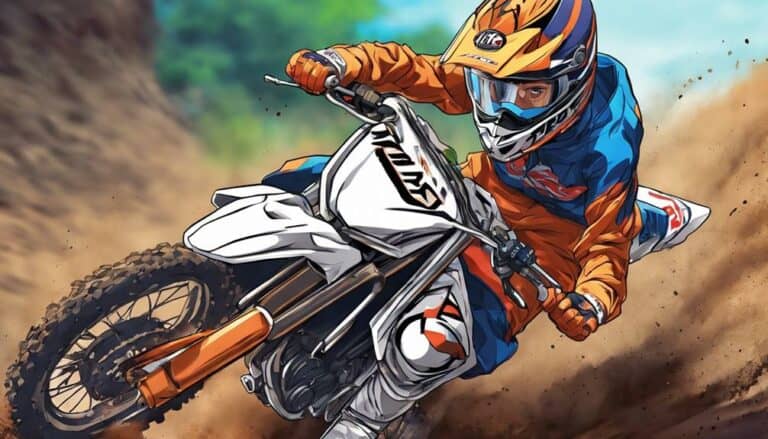When kickstarting your dirt bike, you've probably heard the saying, 'You can't have your cake and eat it too.' Well, when it comes to engaging the clutch, this couldn't be more significant.
The clutch plays a pivotal role in kickstarting your bike, but knowing when to have it in or out can make all the difference in your dirt bike's performance.
So, which news should you have clutch in when kickstarting your dirt bike? Let's find out.
Key Takeaways
- Clutch in during kickstarting prevents sudden movements and protects the bike from damage.
- Proper clutch engagement ensures smooth kickstarting and jerk-free riding.
- Mastering clutch technique enhances control, safety, and precision during kickstarting.
- Pull the clutch lever fully and keep it engaged while kickstarting for effortless performance.
Importance of Engaging Clutch When Kick-Starting
When kick-starting your dirt bike, it's crucial to involve the clutch to make sure a safe and smooth start. By pulling in the clutch lever, you disconnect the engine from the wheels, preventing sudden movements or lurching forward. This simple action not only guarantees your safety but also protects your bike from potential damage that can occur when starting in gear.
Involving the clutch on your bike with clutch allows the engine to turn over freely without transferring power to the wheels. This means you can kick-start your bike without worrying about it unexpectedly taking off on you. Additionally, releasing the clutch after kick-starting allows you to smoothly change into gear and start riding without any jerky movements.
Common Mistakes When Using Clutch
Avoid releasing the clutch too quickly to prevent unexpected lurching forward when kickstarting your dirt bike. Clutch drag, a common mistake when using the clutch during kickstarting, can lead to premature wear and damage to the clutch plates.
Make sure you fully disengage the clutch before kickstarting to prevent the engine from stalling or the bike from not starting. Incorrect clutch adjustment can impact the clutch's engagement and disengagement, affecting the kickstarting process.
Timing is important; engaging the clutch too late in the kickstarting sequence can cause irregular engine turnover or even failure to start. To kick start your dirt bike smoothly and efficiently, be mindful of how you handle the clutch.
Troubleshooting Clutch Issues During Kick-Start
To troubleshoot clutch issues during kick-start, assess the impact of cold temperatures on clutch performance. Cold temperatures can affect the viscosity of the oil in the clutch system, leading to sluggish engagement and disengagement. Below is a table summarizing common clutch issues during kick-starting and their potential solutions:
| Clutch Issue | Troubleshooting Tips |
|---|---|
| Sticking clutch plates | Soak clutch plates in motor oil to guarantee sticking |
| Sudden movement when kick-starting in gear | Use the front brake to guarantee sudden bike movement |
| Temporary sticking due to lack of use | Regularly run the bike to guarantee temporary sticking |
Understanding these issues and applying the suggested solutions can help guarantee your clutch operates smoothly during kick-starting. By taking these steps, you can liberate yourself from the frustration of clutch-related problems and enjoy a seamless kick-starting experience.
Tips for Proper Clutch Engagement
Evaluating proper clutch engagement techniques is key to ensuring a smooth kickstarting experience on your dirt bike. When kickstarting your bike, mastering the art of clutch engagement can make all the difference.
Here are some tips to help you start the bike like a pro:
- Pull the Clutch Lever Fully: Make sure you pull the clutch lever all the way towards the handlebar to disengage the transmission fully.
- Hold the Clutch In: Keep the clutch lever pulled in as you kickstart the bike to prevent any sudden movements.
- Practice Makes Perfect: Spend time practicing proper clutch engagement techniques to start your dirt bike effortlessly every time.
Benefits of Proper Clutch Technique
Mastering the proper clutch technique on your dirt bike can revolutionize your kickstarting experience, ensuring smoother and safer starts every time. Engaging the clutch before kickstarting prevents unwanted movement, keeping the engine power from transferring to the wheels.
By keeping the clutch in while kickstarting, you allow the engine to turn over without engaging the transmission, providing a controlled starting process. This clutch-in kickstarting method acts as a safety measure, preventing accidental acceleration or jerky movements that could lead to loss of control.
When you master the clutch technique, you gain enhanced control and safety when starting your dirt bike. The clutch becomes your ally in kickstarting, offering you the freedom to kickstart confidently without the fear of sudden movements or loss of control.
Embrace the power of proper clutch technique, and elevate your kickstarting experience to a new level of precision and safety.
Conclusion
So, next time you're kickstarting your dirt bike, remember: 'Engage the clutch, avoid the crutch!'
Proper clutch engagement is key to overcoming the drag and friction of wet clutches, ensuring a smooth and successful kickstart every time.
Don't let clutch issues hold you back – with the right technique, you'll be kicking off your ride with ease and confidence.
Ride on!

